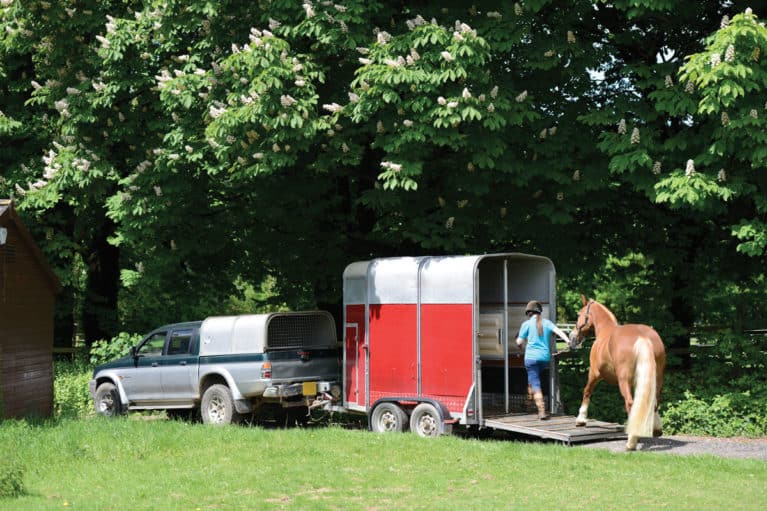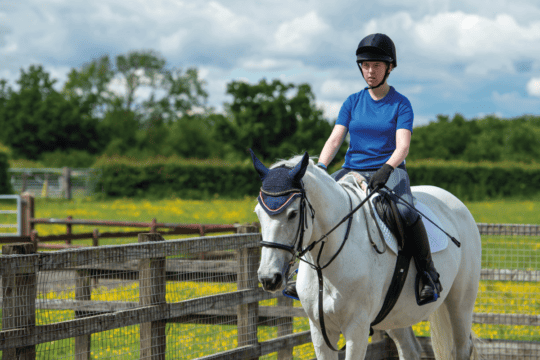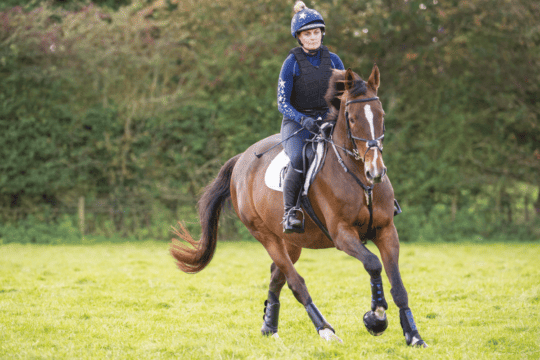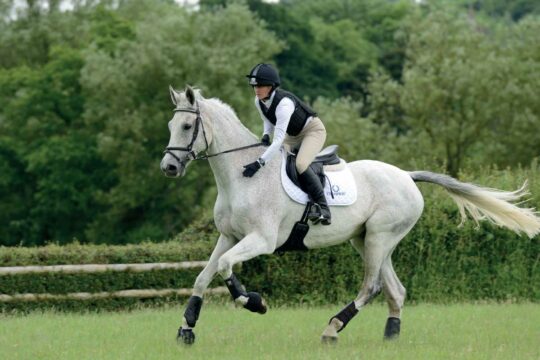Featured Professional

Anna Haines
Anna is a qualified Equine Behaviour Consultant based in Cheshire, who has been around horses for most of her life, having started riding at the age of five. She is a regular contributor to Horse&Rider and is a member of our 'Ask the Expert' team.
Does loading your horse often turn into a battle of wills? Anna Saillet helps take the stress out of travelling

As we start to see the light at the end of the long winter tunnel, you’re probably already dreaming of the wonderful places you and your horse can visit this summer. But before you get too carried away, you need to make sure that travelling is something that he’s happy to do, so your time together can be filled with fun and enjoyment rather than stress and frustration. It’s so easy to sit back and think it’ll all be fine next time you try to load him, but now is the time to help him develop his confidence and ensure that when the time comes to take him somewhere, he’s fully equipped to cope.
While it’s easy to get caught up in the excitement of taking your horse on new adventures, sadly he might not share these feelings. Being taken away from his companions, loaded into a dark, noisy, wobbly box and unloaded in a completely new location can be extremely stressful for him and it’s easy to forget to take this into account. Luckily, there are things that you can do to help minimise the stress he experiences, and putting in the groundwork first can go a long way to making both your lives better and more enjoyable in the long run.
Top tip – Your horse probably has a whole wardrobe of boots, tail bandages and rugs that only come out when he’s travelling. Wearing these can feel a little strange, so introduce them gradually and make wearing them a pleasant experience – why not leave them on while he’s having his tea?
Building confidence
A trailer or lorry is a potentially very frightening place for your horse, so it’s essential to spend time working with him so that he builds a positive association with your mode of transport. Some people choose to leave the vehicle in their horse’s field so he can become used to it. This can be useful, but be aware that it’s unlikely to create a confident loader on its own.
Spend time leading him towards and away from the vehicle, around it and near to it, and see if he wants to touch it. By rewarding him any time he shows interest in the vehicle and as he approaches, it will help him start to realise that the vehicle is actually rather nice to be around. Allow your horse to do this in his own time, rather than you forcing him to get closer. This will mean that his own decision of moving towards the vehicle is what gets him the reward, which will encourage him to make this choice again. It can be tempting to try to pull him forwards a bit more with the leadrope, but maintain a loose contact and allow him to investigate in his own time. It’s important to also allow him to move away from the vehicle if he chooses to – this shouldn’t result in any type of punishment, but instead just ask him to turn back towards the vehicle and reward any behaviour of looking or moving towards it.
Travel buddy
When you’re training your horse to load, it can be helpful to have a companion nearby who’s a confident traveller. Some horses prefer to follow their companion into the vehicle, whereas others may be reluctant to enter if another horse is already inside, particularly in trailers where the second horse has to walk closely behind the first. Remind yourself that each horse has his own preferences, so it’s always worth trying different ways of loading with a companion, but their presence alone will help to minimise your own horse’s stress levels.
It’s also important to ensure that the horses travelling together are happy to be in such close proximity to one another. If you have two horses who you know don’t get along too well, it isn’t advisable to travel them together because this puts them into an extremely small, enclosed space and can lead to problems. Due to the importance of your horse being able to move his head freely during travel, it’s essential that you know he won’t bully the other horse in transit. If this may be a possibility and travelling together is unavoidable, get a strong, sturdy grill to put between them. Suitable travelling companions should always be selected carefully to prevent any problems from arising in the first place.
Top tip – The trick is to keep your training sessions short and sweet. Multiple short sessions are far more likely to be beneficial than a small number of long sessions where your horse has the opportunity to become frustrated or bored.
Let the light in
When you start to think about walking your horse onto the vehicle, try to make the inside of it as light as possible by opening any doors or windows. Your horse’s eyes take much longer to adjust to changes in light levels than yours, so whereas it might take a moment or two for your eyes to adjust from walking from light to dark or vice versa, his can take approximately 20 minutes to adjust to the same level. This means that asking him to walk into a trailer or lorry can be a bit like asking him to walk into a black hole, so be patient and allow him time to adjust to his surroundings. Reward each attempt that he makes to go towards or onto the vehicle – remember, you want him to think of it as a really nice place to be, so make sure your behaviour reflects this. If he’s aware that you’re tense or angry every time you try to get him to go near the vehicle, he will very quickly learn to avoid approaching it altogether.
When he’s going into the vehicle calmly and confidently, gradually go through the steps of closing him in. It’s best to have an assistant at this stage so they can lift the ramp while you stay with your horse. At first, only do it for a moment before opening the ramp up again and unloading him. When he’s first closed in, provide some real jackpot rewards so that this becomes a positive rather than a negative experience for him. You can then slowly increase the time he’s inside, building up in gradual increments of time and ensuring that he remains calm throughout. If at any point you feel he may be starting to get tense, just unload him and go back to the previous step he found easier, and start working again from there.
Top tip – It’s important to teach your horse to remain calm and still in the vehicle, even when the doors are open. This stops him wanting rush out the moment the ramp comes down, and makes loading and unloading safer for everyone involved.
A bumpy ride
We all joke about certain friends or family members being dreadful drivers, but this is a really important consideration to ensure a smooth journey for your horse. A bad or inconsiderate driver can very quickly damage a horse’s confidence. Sharp braking and turning, and rapid deceleration and acceleration can throw him around and make it extremely easy for him to lose his balance. Using a camera in the horse area to observe how he copes with travel can be really eye opening and help to highlight whether there are issues with the way that he travels or how he’s being driven.
Training runs
When you’ve mastered the art of loading and unloading calmly and confidently, it’s time to head out on some short drives with your horse. It’s really beneficial for any horse’s training to do plenty of short trips in a vehicle instead of only ever loading to go to an event. Short, smooth journeys will build his confidence and help him to understand that he’ll come home again after a trip. Bear in mind that many horses develop negative associations with horseboxes because they’re often transported in them to new homes, which can be very stressful. Since we can’t explain this to them, all they know is that sometimes when they enter a vehicle they end up in a completely alien place, never to see their closest companions again. Sometimes their whole lives are turned upside down – their owners change, their routine changes, the rules change and everything about the life they previously knew becomes different. I wonder how long it would take us humans to become nervous about car travel if every so often we were kidnapped and taken to a completely new life without any explanation. Short, easy drives that end up right back in a familiar place can go a long way to boosting your horse’s confidence.
Balancing act
There are various types of horse transport vehicles, each with different options for which direction your horse faces during transit. Although trailers are typically forward-facing, this hasn’t been found to be particularly comfortable for horses because they often find it difficult to balance. Rear-facing vehicles allow your horse to rest his weight on his hindquarters when the vehicle is braking, which appears to make balancing easier, and the herringbone position found in most lorries also seems to provide a good option. This is something that varies from horse to horse and each will have their own preference.
Equally, considering whether to use partitions in a trailer or remove them may require a small amount of experimentation to establish your horse’s preferences. Many people report that, despite our assumption that the partitions help a horse to balance, their horses have found it much easier without them.
Being able to balance is vital for a smooth, calm journey and for this your horse needs to be able to move his head. Many people tie their horse up tightly during travel, but this impedes his balancing ability and will likely make travelling much more difficult for him. A loose rope is recommended to allow him to move his head freely, which will allow him to balance properly throughout the journey.
Signs of stress
It’s essential to give your horse a haynet when he’s travelling so he can eat if he wants to. Horses shouldn’t be left for long periods without access to forage and even if he doesn’t appear to eat while travelling, he should always have the option. It’s likely that he’s feeling stressed if he doesn’t eat or if he really snatches at the haynet when he does. Equally, if you find that he’s defecating regularly, particularly if his droppings have a very loose consistency, it’s likely that he’s finding the situation stressful, so try extra training to build his confidence.
Fit for purpose
Ensuring your vehicle is in a good state of repair is absolutely essential. Horses are sensitive animals who can often detect that something isn’t quite right before we can. If your horse has always loaded well and this behaviour suddenly changes, it’s important to do a thorough check of the vehicle. It could be that he has detected a weakness in the floor or a noise from something that’s come loose during transit that he finds worrying. I’ve known horses who have demonstrated this behaviour and, on inspection of the horsebox, the floor has been found to be going rotten. It’s likely that this felt unstable to the horse during travel and as soon as the floor was replaced, he went back to loading calmly and confidently once again.
Stand your ground
Loading problems are a very common reason for people to contact an equine behaviourist for help, but often before doing this they’ve tried an array of different tactics to get their horse to load. Many of these tactics result in violent methods being used, often because other people have volunteered their help. It can be frustrating when your horse refuses to load and when other people are present it can feel embarrassing, too. It takes a great deal of strength to stick to your guns and quietly thank people for their offers of help, while continuing to work calmly with your horse. The bottom line is simple – if you want to travel with your horse, you must find a way to make the horsebox a nice place to be. No amount of shouting, or waving sticks or lunge lines around will achieve this.
So, before the summer season arrives, make it a priority to spend some time building your horse’s confidence in and around the horsebox so you can prevent any tricky or embarrassing situations from arising. If you’re in any doubt on how to proceed, simply ask for help from your local qualified equine behaviourist, who will help you to work through any problems you might be having.
Your Comments
One thought on “Take the stress out of travelling”
Leave a Reply
You must be logged in to post a comment.









My pony loads fine and has always travelled well then one day got his legs over bar and ever since then his behaviour seems the same and tries to do it everytime have had to have a bar fitted to prevent him doing this. I have travelled in back of wagon and seems to be fine then every now and then he will start jumping up. He is fine on box but the minute we close the door he starts. We went put last week and took another horse with us and he was brillant but carnt keep doing this why do you think he may be do9ng this ?